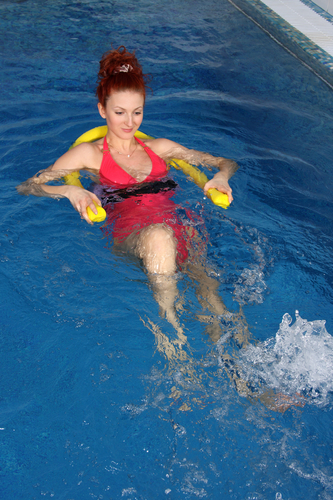 Is your back starting to talk to you—but not in a nice way? Try one of these approaches to ease your pain and feel strong and comfortable in your body again.
Is your back starting to talk to you—but not in a nice way? Try one of these approaches to ease your pain and feel strong and comfortable in your body again.
According to the American Pregnancy Association, between 50 and 70 percent of pregnant women experience back pain at some point during their pregnancy. But, just because it’s common—and usually not a sign of anything worrisome—it doesn’t mean you have to resign yourself to nine months of misery. Although medication is generally off the table as a method of treatment, there are myriad remedies that doctors and holistic health practitioners recommend to help ease back pain, or even relieve it completely. Here are 10 you can try to keep your body as comfortable as possible while it does the most important work it’s ever done—growing your baby.
1. Prenatal Yoga
Yoga, a movement-based strength and flexibility practice with roots in ancient India, is one of the most popular techniques women turn to for pain relief, and prenatal yoga is a top choice among pregnant women whose backs, muscles, joints, and nerves are hurting under the weight of pregnancy. Prenatal yoga can help improve posture and “tone the physical body in preparation for the birthing process,” says Liz Owen, a Boston-area yoga teacher and the co-author of Yoga for a Healthy Lower Back: A Practical Guide to Developing Strength and Relieving Pain. Prenatal yoga also tackles emotional stress with deep, mindful breathing exercises that can strengthen and empower. Plus, yoga practice can help you sleep better and relax your mind and muscles. “In the midst of changing hormones and emotions, yoga provides a grounding and focus,” Owen says.
2. Acupuncture
Acupuncture is an East Asian medical technique in which very fine needles are inserted into specific pressure points on the body that correspond with various systems of physical and emotional health. Acupuncture removes any blockages that are interfering with the smooth flow of the body’s energy, called qi (pronounced “chee”). Stimulating acupuncture points, either through needle insertion or acupressure, a technique in which the practitioner uses fingers instead of needles, can help improve digestion, boost your energy level, and bring relief from morning sickness, migraine headaches, and back pain. Studies have shown direct positive correlation between acupuncture and pregnancy back pain relief, and many women swear by its effectiveness, but acupuncture must be administered correctly to prevent unwanted side effects such as nausea, headaches, and over-stimulation that can induce labor. Consult with your doctor first to make sure acupuncture is right for you, and then find a certified therapist who has experience working with pregnant women.
A certified prenatal massage therapist can bring quick relief when back pain is acute, especially when it’s the result of muscular clenching that irritates nerves (particularly the sciatic nerve in the buttocks and legs) and sends pain signals to the brain. Research has shown that in addition to relieving pain, regular prenatal massage can help alleviate depression and anxiety in pregnancy. Swedish massage is the most common and advisable method of prenatal massage because it is gentle and soothing, and it uses long, smooth strokes that won’t aggravate the joints or push fluid through the body in an unhealthy way. Women should first consult with their doctors to make sure prenatal massage is safe and then make sure the prenatal massage therapist is certified. To be comfortable on the massage table, a side-lying position is usually best.
4. Chiropractic Care
You may associate chiropractors with joint-“cracking” adjustments, but they actually use a range of techniques to relieve back pain, and many women find relief under the care of someone experienced. Chiropractors routinely use joint manipulation (which can cause that popping sound), soft tissue work, and prescribed exercises to prevent women from feeling muscular tightness, nerve compression, and joint misalignment.
5. Physical Therapy
Physical therapists, in addition to treating acute injuries, help pregnant women work through back pain by manipulating joints, muscles, and nerve pressure points and providing exercises that expectant moms can continue at home.
6. Meditation
Unlike yoga or massage, meditation is a technique that you can access at any time, in any place, no appointment necessary. There are numerous ways to practice meditation. One is to simply sit or lie down in a quiet place and focus on breathing mindfully, inhaling and exhaling deeply. You can meditate in silence or listen to calming music or a guided audio program, which can be generic (“imagine a beautiful beach”) or pregnancy-specific (“feel waves of love enveloping your growing baby”). Meditation has been shown to elicit a biological “relaxation response,” which stimulates the brain to control its release of stress hormones. When stress is kept in check, its toxic effects (such as high blood pressure and muscle tension) are reduced. By meditating regularly, you can also increase your pain tolerance level, which can come in handy both when managing back pain and in coping with labor and delivery pain.
7. Swimming
Swimming is one of the most highly recommended forms of exercises for pregnant women because it “takes the pressure off the spine.” says Mary Rosser, M.D., Ph.D., an OBGYN in Bronx, New York. When you’re suspended in the water, gravity has no effect on your body, and “you’re weightless in the water,” Dr. Rosser says. Merely paddling up and down the pool lanes will help decompress your spine and tone your legs, arms, and back and core muscles. As you experience full-body movement in a safe space, breathe deeply and fully to stay afloat—the deep breathing will help you relax emotionally as well as physically. And as you move further into your pregnancy, swimming the breaststroke can strengthen the chest and back muscles. Always stay well hydrated while swimming and stop if you feel dizzy or lightheaded at any point. If you have a high-risk pregnancy, talk with your doctor before you head to the pool.
8. Sleep Support
Sleep can be elusive during pregnancy, especially if your back is hurting, because most women tend to sleep on their sides. In this position, the spine is like a telephone wire that’s hanging between the two poles of your shoulders and your pelvis. To support your back and prevent pain, fold a thick towel lengthwise and place it perpendicular to your body at the point on your waist where your spine is its most “droopy.” The towel’s length will ensure support without requiring readjustment, even if you roll over during the night. Or, try sleeping on your side with a pillow between your knees to reduce the strain on your pelvis and lower back. Side sleeping is important as the pregnancy develops past the first trimester—it optimizes blood flow to the baby, Dr. Rosser says. Sleeping flat on your back is not good for you or the baby; it is also very uncomfortable, she adds. Body pillows are helpful for supporting your chest, hips, and lower back. Experts advise sleeping on a firm mattress (Dr. Rosser suggests placing a wooden board under your mattress if you have a soft one), and following smart sleep habits such as maintaining a consistent sleep schedule and relaxing bedtime routine, using your bed only for sleep and sex, avoiding bright screens just before bed, keeping the space cool and dark, and not eating for at least two to three hours before bedtime.
 9. Wear a Maternity Belt
9. Wear a Maternity Belt
A maternity belt, which you can buy online and in many maternity clothing shops, is a supportive undergarment that helps hold up the belly so the pelvic girdle and lower back aren’t too strained. If your belly is protruding forward in a pronounced way, rather than with your weight diffused across your midsection, the belt can act as a substitute for your abdominal core muscles, which can struggle to prevent your lower spine from painfully exaggerating its curvature. Doctors generally advise women to try maternity belts and use them if they work, but the belts should be seen as a complement to other remedies rather than the only treatment for back pain in pregnancy.
10. Wear the Proper Shoes
You may be a fashion maven who receives regular compliments on your maternity style, but if you’re wearing high-fashion (read: high-heeled) shoes, you’re not doing your back any favors. “High heels increase the curvature of your back and create pressure” that drives the weight of your pregnancy directly into your lower spine and hip joints, Dr. Rosser says. You may also lose your balance—your weight shifts as the pregnancy advances and the center of gravity changes—and heels cause you to be less stable. But walking in flats isn’t the answer either, because they leave your feet, which tend to spread during pregnancy because of hormonal changes, unsupported. Poor foot position can manifest itself as imbalance and pain all the way up your legs and back. To get the best support—and to relieve the most pressure—Dr. Rosser advises a low-heeled shoe that is comfortable with either a built-in arch support or an orthotic insertion. The slight rise of the low heel will help distribute the weight that’s on your legs in a more stable and back-supportive way.
Source: www.parents.com; Holly Lebowitz Rossi; 2014.











